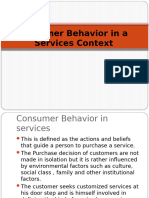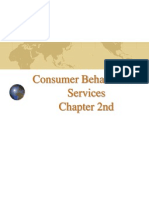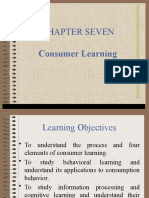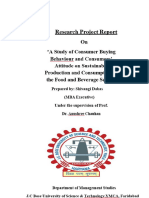Chapter 2 Consumer Behaviour in Services
Uploaded by
Hanchalu LikesaChapter 2 Consumer Behaviour in Services
Uploaded by
Hanchalu LikesaCHAPTER 2 – CONSUMER BEHAVIOUR IN SERVICES
2.1 INTRODUCTION
Consumer orientation lies at the heart of the marketing concept.
As marketers; we are required to understand our consumers and to build our
organizations around them. As Jeff Bezos of Amazon.com puts it, “We see our
customers as invited guests to a party, and we are the hosts. It’s our job every day to
make every important aspect of the customer experience a little bit better.”2
Understanding consumers and improving the experience is particularly important for
services, which in many instances still tend to be operations-dominated rather than
customer-oriented. them, and how they evaluate these services once they have
received them.
Throughout the three primary stages of the consumer decision making—pre-purchase,
consumption and post purchase evaluation—the consumer must be using a process or
model to make his or her decision. Although a variety of models has been developed
and is discussed in this chapter, it is important to point out that no model is wholly
accurate. The consumer’s mind is still closed to us; it is a “black box” that remains
sealed. We can observe inputs to the box and the decisions made as a result, but we
can never know how the act of processing inputs (information) truly happens.
2.2 THE CONSUMER DECISION PROCESS: AN OVERVIEW
To market services effectively, marketing managers need to understand the thought
processes used by consumers during each of the three stages of the consumer
decision process: the prepurchase choice among alternatives, the consumer’s
reaction during consumption, and the post purchase evaluation of satisfaction (see
Figure 4.1).
CHAPTER 2 – CONSUMER BEHAVIOUR IN SERVICES Page 1 of 9
2.2.1 The Prepurchase Stage: The Stimulus
The prepurchase stage of the consumer decision process refers to all consumer
activities occurring before the acquisition of the service. This stage begins when an
individual receives a stimulus that incites a consumer to consider a purchase. The
stimulus may be a commercial cue, a social cue, or a physical cue. Commercial cues
are the result of promotional efforts. Similarly, social cues are obtained from the
individual’s peer group or from significant others. the stimulus may also be the result of
a physical cue such as thirst, hunger, or various other biological cues.
2.2.2 The Prepurchase Stage: Problem Awareness
Problem awareness occurs when consumers realize that they need to do something to
get back to a normal state of comfort. During the problem awareness phase of
consumer decision making, the consumer examines whether a need or want truly exists
for the product category. Ultimately, needs are unsatisfactory conditions of the
consumer that prompt him or her to an action that will make the condition better. In
contrast, wants are desires to obtain more satisfaction than is absolutely necessary to
improve an unsatisfactory condition. Accordingly, problem awareness may be based on
a shortage (a need) or on an unfulfilled desire (a want).
2.2.3 The Prepurchase Stage: Information Search
The awareness of a problem demands a solution from the individual, and usually
implies that a potential purchase will ensue. The individual searches for alternatives
during the information search phase of the prepurchase stage. Alternatives that the
CHAPTER 2 – CONSUMER BEHAVIOUR IN SERVICES Page 2 of 9
consumer actually remembers at the time of decision making are referred to as the
evoked set. Of the brands in the evoked set, those considered unfit (e.g., too
expensive, too far away, etc.) are eliminated right away. The remaining alternatives are
termed the consideration set. An internal search accesses the consumer’s own
memories about possible alternative colleges. The internal search may be followed by
an external search.
2.2.4 The Prepurchase Stage: Evaluation of Alternatives
Once relevant information has been collected from both internal and external sources,
the consumer arrives at a consideration set of alternative solutions to resolve the
recognized problem. The possible solutions are considered in the evaluation of
alternatives phase of the consumer decision process. This phase may consist of a
nonsystematic evaluation of alternatives, such as the use of intuition—simply
choosing an alternative by relying on a “gut-level feeling”—or it may involve a
systematic evaluation technique, such as a multi-attribute choice model. Such
systematic models utilize a set of formalized steps to arrive at a decision.
Another type of multi-attribute approach that has been suggested is the lexicographic
approach. This approach describes so-called “lazy decision makers” who try to
minimize the effort involved. They look at each attribute in turn, starting with the most
important, and try to make a decision.
2.2.5 The Consumption Stage: Choice
During this consumption stage, the consumer may make a store choice—deciding to
purchase from a particular outlet, or a nonstore choice—deciding to purchase from a
catalog, the Internet, or a variety of mail-order possibilities. This decision is
accompanied by a set of expectations about the performance of the product to be
purchased. In the case of goods, the consumer then uses the product and disposes of
any solid waste remaining. The activities of buying, using, and disposing are grouped
together and labeled the consumption process.
CHAPTER 2 – CONSUMER BEHAVIOUR IN SERVICES Page 3 of 9
2.2.6 The Post purchase Stage: Postpurhase Evaluation
Once a purchase has been made and as the product, whether a service or a good is
being consumed, post purchase evaluation takes place. During this stage, consumers
may experience varying levels of cognitive dissonance—doubt that the correct
purchase decision has been made. Marketers often attempt to minimize the consumer’s
cognitive dissonance by reassuring the customer that the correct decision has been
made.
2.3 SPECIAL CONSIDERATIONS PERTAINING TO SERVICES
Although the consumer decision process model applies to both goods and services,
unique considerations arise with respect to service purchases. Many of these special
considerations can be directly attributed to the unique service characteristics of
intangibility, inseparability, heterogeneity and perishability.
2.3.1 Prepurchase Stage Considerations: Perceived Risk
In contrast to consumers when purchasing goods, consumers of services tend to
perceive a higher level of risk during the prepurchase decision stage.
Consequently, perceived risk is proposed to consist of two dimensions:
• Consequence, the degree of importance and/or danger of the outcomes derived from
any consumer decision.
• Uncertainty, the subjective possibility of the occurrence of these outcomes.
Types of Risk As the idea of consumer perceived risk developed, five types of
perceived risk were identified that were common in many purchase situations, based on
five different kinds of outcomes: financial, performance, physical, social, and
psychological.
Risk and Standardization Much of the heightened level of perceived risk can be
attributed to the difficulty in producing a standardized service product. Perceived risk,
CHAPTER 2 – CONSUMER BEHAVIOUR IN SERVICES Page 4 of 9
therefore, tends to be higher for purchasing services in contrast to the purchase of
goods.
Co-Producer Risk The involvement of the consumer in the “production process of
services” is another source of increased perceived risk. Co-producer risk is directly
related to the concept of inseparability. Dental services provide a great example of the
consumer’s involvement in the production process.
Risk and Information Others have argued that the higher levels of risk associated with
service purchases are due to the limited information that is readily available before the
consumer makes the purchase decision. For example, the economics literature
suggests that goods and services possess three different types of attributes:
• Search attributes—attributes that can be determined prior to purchase.
• Experience attributes—attributes that can be evaluated only during and after the
production process.
Credence attributes—attributes that cannot be evaluated confidently, even
immediately after receipt of the good or service.
Search attributes typically consist of tangibles that can be evaluated prior to purchases.
A large proportion of the properties possessed by services (e.g., the friendliness of the
flight attendants of a particular airline or the skill level of a hairstylist) can be discovered
by consumers only during and after the consumption of the service; these are referred
to as experience attributes.
Risk and Brand Loyalty If we start with the premise that consumers do not like taking
risks, it would seem obvious that they will try, whenever possible, to reduce risk during
the purchase process. One strategy is to be brand- or store-loyal.
CHAPTER 2 – CONSUMER BEHAVIOUR IN SERVICES Page 5 of 9
2.3.2 Prepurchase Stage Considerations: The Importance of Personal Sources of
Information
Another special consideration during the prepurchase stage is the importance of
personal sources of information. Research has shown that in the area of
communications, personal forms such as word-of-mouth references and information
from opinion leaders are often given more importance than company-controlled
communications, such as mass advertising. A reference from a friend becomes more
important when the purchase to be made has a greater risk.
2.3.3 Prepurchase Stage Considerations: Fewer Alternatives to Consider
In comparison with goods, another difference for service marketers to consider is that
consumers of services tend to evaluate a smaller number of alternative sources of
supply during the prepurchase stage. This situation occurs for a variety of reasons.
First, each service provider tends to offer only one brand. For example, Geico Insurance
sells only one brand of insurance—Geico. Similarly, your dentist provides only one
brand of dental care. In contrast, consumers shopping for a blender generally have
many brands to consider at each retail location.
The second reason the consideration set tends to be smaller pertains to the number of
establishments providing the same service. Services tend to have a smaller number of
outlets providing the same service.
2.3.4 Prepurchase Stage Considerations: Self-Service as a Viable Alternative
The final, but important, difference between goods and services in the prepurchase
choice stage of the consumer decision process is that self-provision often becomes a
viable alternative for such services as lawn care, fence installation, housekeeping,
painting, and a number of other services. In comparison, consumers rarely consider
building a refrigerator over purchasing one from a local retailer. Consequently, many
service providers must consider the customer’s own self-provision as a viable
competitor in the marketplace.
CHAPTER 2 – CONSUMER BEHAVIOUR IN SERVICES Page 6 of 9
2.3.5 Consumption Stage Considerations
The consumption of goods can be divided into three activities: buying, using, and
disposing.
This scenario does not apply to the consumption of services, however. First of all, no
clear-cut boundary or definite sequence exists between the acquisition and the use of
services because there is no transfer of ownership. Because of the prolonged
interactions between the customer and the service provider, the production, acquisition,
and use of services become entangled and appear to be a single process. Furthermore,
the concept of disposal is irrelevant because of the intangibility and experiential nature
of services.
2.3.6 Post choice Considerations
The post purchase evaluation of services is a complex process. It begins soon after the
customer makes the choice of the service firm he or she will be using and continues
throughout the consumption and post consumption stages. The evaluation is influenced
by the unavoidable interaction of a substantial number of social, psychological, and
situational variables. Service satisfaction relies not only on the properties of the four
elements of the servuction system—contact personnel, inanimate environment, other
customers, and internal organization systems—but also on the synchronization of these
elements in the service production/consumption process.
Post choice Models: The Expectancy Disconfirmation Theory
How does service satisfaction arise during the consumption and post purchase stages?
A number of approaches have been suggested, but perhaps the simplest and most
powerful is the expectancy disconfirmation theory. The basic concept behind this
explanation is straightforward. Consumers evaluate services by comparing expectations
with perceptions. If the perceived service is better than or equal to the expected service,
then consumers are satisfied.
Hence, ultimately customer satisfaction is achieved through the effective management
of customer perceptions and expectations.
CHAPTER 2 – CONSUMER BEHAVIOUR IN SERVICES Page 7 of 9
Post choice Models: The Perceived-Control Perspective
Another explanation that assists in describing the post purchase stage is the perceived-
control perspective. Over the years, the concept of control has drawn considerable
attention from psychologists.
The basic premise of this perspective is that during the service experience, the higher
the level of control over the situation perceived by consumers, the higher their
satisfaction with the service will be. A similar positive relationship is proposed between
service providers’ experience of control and their job satisfaction.
Thus, when consumers perceive that they are in control, or at least that what is
happening to them is predictable, the effect can be the same as that achieved by
behavioral control. In other words, it is the perception of control, not the reality that is
most important.
It is equally important to an airline that delays a flight after passengers have boarded
but fails to let them know what is happening or how long the delay will be. In both
situations, customers will feel that they have lost control over the situation, which
eventually tends to result in customer dissatisfaction.
Post choice Models: The Script Perspective—All the World’s a Stage and All the
People Players
A number of theories in psychology and sociology can be brought together in the ideas
of a script. The script perspective proposes that rules, mostly determined by social
and cultural variables, exist to facilitate interactions in daily repetitive events, including a
variety of service experiences. These rules shape the participants’ expectations in these
types of interactions.
The given chapter contents are compiled from the given source. [ CITATION Hof11 \l 1033 ]
Works Cited
Hoffman, K. D., & Bateson, J. E. (2011). Services Marketing Concepts, Strategies & Cases. Mason, OH:
South-Western Cengage Learning
CHAPTER 2 – CONSUMER BEHAVIOUR IN SERVICES Page 8 of 9
CHAPTER 2 – CONSUMER BEHAVIOUR IN SERVICES Page 9 of 9
You might also like
- Ahead of the Curve: Using Consumer Psychology to Meet Your Business GoalsFrom EverandAhead of the Curve: Using Consumer Psychology to Meet Your Business GoalsNo ratings yet
- Three Stage Model of Service Consumption PDFNo ratings yetThree Stage Model of Service Consumption PDF50 pages
- Chapter 2 Consumer Behavior in A Service ContextNo ratings yetChapter 2 Consumer Behavior in A Service Context23 pages
- Services Marketing Lecture Slides - Chapter 2No ratings yetServices Marketing Lecture Slides - Chapter 271 pages
- Lesson 3 - Consumer Behavior in ServicesNo ratings yetLesson 3 - Consumer Behavior in Services20 pages
- Services Marketing Focus On The Customer: Faculty: Kerena AnandNo ratings yetServices Marketing Focus On The Customer: Faculty: Kerena Anand6 pages
- Unit-4Relationship Marketing, Consumer BehaviorNo ratings yetUnit-4Relationship Marketing, Consumer Behavior33 pages
- Consumer Behaviour in Services Chapter 2ndNo ratings yetConsumer Behaviour in Services Chapter 2nd13 pages
- Customer Behavior in Service EncountersNo ratings yetCustomer Behavior in Service Encounters41 pages
- Consumer Behavior in The Service Business ContextConsumer Behavior in The Service Business Contextbab3No ratings yetConsumer Behavior in The Service Business ContextConsumer Behavior in The Service Business Contextbab312 pages
- Evaluation of Alternatives: Search Attributes - TangibleNo ratings yetEvaluation of Alternatives: Search Attributes - Tangible3 pages
- 5 - Topic 1 - Service Consumer Behaviour - ANo ratings yet5 - Topic 1 - Service Consumer Behaviour - A2 pages
- Consumer Behavior - You Are What You BuyNo ratings yetConsumer Behavior - You Are What You Buy31 pages
- Customer Behavior in Service EncountersNo ratings yetCustomer Behavior in Service Encounters39 pages
- TsiotsouWirtz TheThree-StageModelofServiceConsumption 20151No ratings yetTsiotsouWirtz TheThree-StageModelofServiceConsumption 2015124 pages
- Investment Valuation: Learn Proven Methods For Determining Asset Value And Taking The Right Investing DecisionsFrom EverandInvestment Valuation: Learn Proven Methods For Determining Asset Value And Taking The Right Investing DecisionsNo ratings yet
- Determinants of Cross-Functional Sales Performance Variables in It/ItesNo ratings yetDeterminants of Cross-Functional Sales Performance Variables in It/Ites17 pages
- Journal of Current Issues and Research in AdvertisingNo ratings yetJournal of Current Issues and Research in Advertising54 pages
- Marketing Strategy of Perfume World in The Light of Consumer Behavior in Bangladesh100% (1)Marketing Strategy of Perfume World in The Light of Consumer Behavior in Bangladesh31 pages
- Factors Influ What Are The Reasons For Purchase Decision of Customers Towards V-Guard WairesNo ratings yetFactors Influ What Are The Reasons For Purchase Decision of Customers Towards V-Guard Waires4 pages
- Chapter No 6 Business Markets and Business Buyer BehaviorNo ratings yetChapter No 6 Business Markets and Business Buyer Behavior15 pages
- The Factors Influencing Consumer BehaviorNo ratings yetThe Factors Influencing Consumer Behavior15 pages
- Assignment For Tourism and Hospitality Marketing CourseNo ratings yetAssignment For Tourism and Hospitality Marketing Course33 pages
- The Effect of Corporate Social Responsibility On Consumer Purchase Decisions With Corporate Image and Brand Image As InterveningNo ratings yetThe Effect of Corporate Social Responsibility On Consumer Purchase Decisions With Corporate Image and Brand Image As Intervening13 pages
- Factors Influencing Milk Powder Brand Preference: A Case From Kegalle District of Sri LankaNo ratings yetFactors Influencing Milk Powder Brand Preference: A Case From Kegalle District of Sri Lanka18 pages
- Evaluation of Alternative Is The Most Important Stage For Consumer Buying Behavior: The Case Study of Pizza HutNo ratings yetEvaluation of Alternative Is The Most Important Stage For Consumer Buying Behavior: The Case Study of Pizza Hut95 pages
- Marketing Management - Assignment Question 1-Explain The Steps in Business Buying ProcessNo ratings yetMarketing Management - Assignment Question 1-Explain The Steps in Business Buying Process8 pages
- A Study of Consumer Buying Behaviour Towards Online Food Delivery App in The Youth of Ranchi District of JharkhandNo ratings yetA Study of Consumer Buying Behaviour Towards Online Food Delivery App in The Youth of Ranchi District of Jharkhand16 pages
- CONSUMER BEHAVIOUR & ADVERTISING MANAGEMENT UNIT 2No ratings yetCONSUMER BEHAVIOUR & ADVERTISING MANAGEMENT UNIT 241 pages
- Principles of Marketing, 19th Global Edition Philip Kotlerdownload100% (1)Principles of Marketing, 19th Global Edition Philip Kotlerdownload51 pages
- Ahead of the Curve: Using Consumer Psychology to Meet Your Business GoalsFrom EverandAhead of the Curve: Using Consumer Psychology to Meet Your Business Goals
- Services Marketing Focus On The Customer: Faculty: Kerena AnandServices Marketing Focus On The Customer: Faculty: Kerena Anand
- Consumer Behavior in The Service Business ContextConsumer Behavior in The Service Business Contextbab3Consumer Behavior in The Service Business ContextConsumer Behavior in The Service Business Contextbab3
- Evaluation of Alternatives: Search Attributes - TangibleEvaluation of Alternatives: Search Attributes - Tangible
- TsiotsouWirtz TheThree-StageModelofServiceConsumption 20151TsiotsouWirtz TheThree-StageModelofServiceConsumption 20151
- Investment Valuation: Learn Proven Methods For Determining Asset Value And Taking The Right Investing DecisionsFrom EverandInvestment Valuation: Learn Proven Methods For Determining Asset Value And Taking The Right Investing Decisions
- Determinants of Cross-Functional Sales Performance Variables in It/ItesDeterminants of Cross-Functional Sales Performance Variables in It/Ites
- Journal of Current Issues and Research in AdvertisingJournal of Current Issues and Research in Advertising
- Marketing Strategy of Perfume World in The Light of Consumer Behavior in BangladeshMarketing Strategy of Perfume World in The Light of Consumer Behavior in Bangladesh
- Factors Influ What Are The Reasons For Purchase Decision of Customers Towards V-Guard WairesFactors Influ What Are The Reasons For Purchase Decision of Customers Towards V-Guard Waires
- Chapter No 6 Business Markets and Business Buyer BehaviorChapter No 6 Business Markets and Business Buyer Behavior
- Assignment For Tourism and Hospitality Marketing CourseAssignment For Tourism and Hospitality Marketing Course
- The Effect of Corporate Social Responsibility On Consumer Purchase Decisions With Corporate Image and Brand Image As InterveningThe Effect of Corporate Social Responsibility On Consumer Purchase Decisions With Corporate Image and Brand Image As Intervening
- Factors Influencing Milk Powder Brand Preference: A Case From Kegalle District of Sri LankaFactors Influencing Milk Powder Brand Preference: A Case From Kegalle District of Sri Lanka
- Evaluation of Alternative Is The Most Important Stage For Consumer Buying Behavior: The Case Study of Pizza HutEvaluation of Alternative Is The Most Important Stage For Consumer Buying Behavior: The Case Study of Pizza Hut
- Marketing Management - Assignment Question 1-Explain The Steps in Business Buying ProcessMarketing Management - Assignment Question 1-Explain The Steps in Business Buying Process
- A Study of Consumer Buying Behaviour Towards Online Food Delivery App in The Youth of Ranchi District of JharkhandA Study of Consumer Buying Behaviour Towards Online Food Delivery App in The Youth of Ranchi District of Jharkhand
- CONSUMER BEHAVIOUR & ADVERTISING MANAGEMENT UNIT 2CONSUMER BEHAVIOUR & ADVERTISING MANAGEMENT UNIT 2
- Principles of Marketing, 19th Global Edition Philip KotlerdownloadPrinciples of Marketing, 19th Global Edition Philip Kotlerdownload





































































































